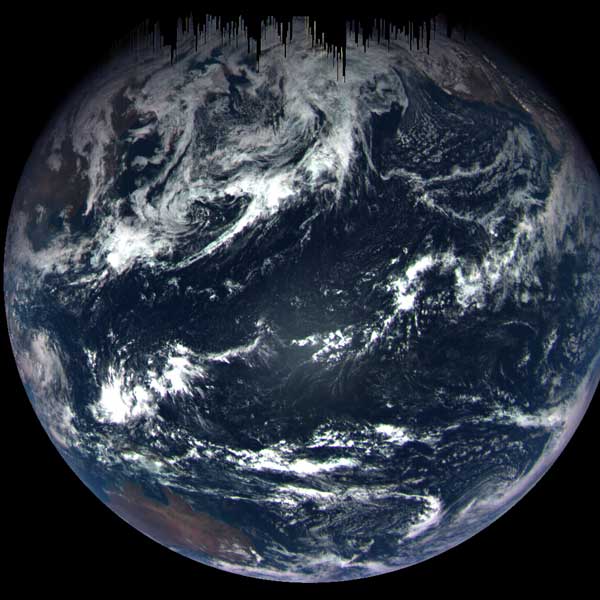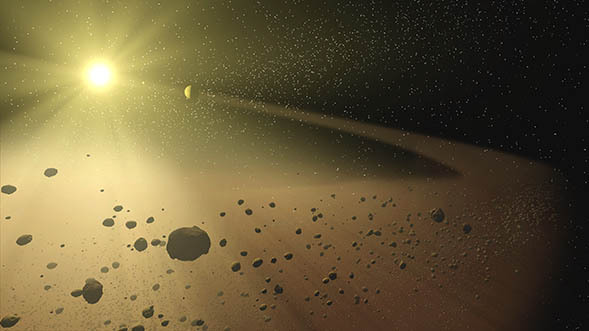Where did Earth’s water come from? One of the oldest meteorites on Earth is adding new pieces to an old puzzle.

NASA / Goddard / University of Arizona
Some of the first minerals to form in the solar system might tell us where Earth’s water came from.
Meteorites sometimes contain ancient rocks known as calcium-aluminum-rich inclusions (CAIs), formed of minerals that condensed long ago in the hot solar nebula, the cloud of gas and dust from which the Sun and planets came together. As the nebula cooled, these were the first bits of rock to solidify, in the first 200,000 years of our 4.6 billion-year-old system.
These mineral relics were preserved within asteroids, which incorporated them as they grew. Now, we can still find them inside primitive meteorites — and catch a glimpse of the environment in which they formed.
Jérôme Aléon (National Museum of Natural History, France) and colleagues investigated hydrogen trapped within several CAIs in a meteorite found in soviet Kazakhstan in 1962, known as the Efremovka meteorite. This measurement, reported in Nature Astronomy, might tell us where Earth’s water came from.
Was Earth Born Dry?
For a long time, astronomers thought that the terrestrial planets formed too close to the newborn Sun to harbor any water. The solar nebula in this region would have been about 2000K (3000°F), too hot for hydrogen or oxygen to be trapped in rocks. So the inner planets must have formed dry, their water later delivered by a rain of “wet” rocks, such as comets and asteroids, from the outer solar system.
But in recent years, astronomers have realized that the water from the inner and outer solar system is not the same. The difference lies in the hydrogen atoms within the water molecules. A fraction of these atoms have an extra neutron in their structure, keeping their chemical properties unchanged but increasing their molecular weight. These heavy hydrogen atoms are known as deuterium.
Water’s deuterium-to-hydrogen ratio (D/H) reveals its origin. Many processes increase the D/H ratio over time because lighter hydrogen is more likely to react or get stripped away by radiation, while heavier deuterium tends to stay put.
To their surprise, Aléon and his team found two distinct D/H ratios in Efremovka’s CAIs. The first signal came from a primitive mineral trapped inside a larger CAI, which preserved the mineral over the eons. The mineral had extremely low amounts of deuterium, with a D/H ratio much lower than that of Earth’s ocean water. The team thinks that it condensed directly from the solar nebula. Its low amount of deuterium matches what theory had predicted, but according to Aléon, this is the first time such a low D/H has been measured in a meteorite.

NASA / JPL-Caltech / T. Pyle (SSC)
They also analyzed other minerals containing oxidized iron and found that they had been exposed to water vapor before the parent asteroid captured the fragments. These were also preserved inside a larger CAI, but their D/H ratios were similar to ocean water.
The two different results only make sense if the minerals that got trapped first only encountered pristine hydrogen gas with no water and no deuterium, while those that were still exposed to the environment even a little bit later encountered a gas with more water and hydrogen isotopic composition similar to that of Earth’s. In other words, most of the minerals formed among water vapor that had the same hydrogen isotopic composition of Earth’s water.
CAIs generally form at the inner edge of the protoplanetary disk. “That’s where the planets formed,” Aléon says. So if they encountered deuterium-rich gas there, that means the disk itself had water vapor with the hydrogen isotopic composition of the Earth.
“This gas, it's exactly the same as what we have on Earth, so they have the same source,” Aléon says. “Because the gas is older, it's probably the source of what we have on Earth. You don’t need to bring anything else.”
The researchers suggest that this water came from the interstellar medium, dragged in as the solar nebula collapsed. It would already have been rich in deuterium because of chemical reactions occurring out in the cold space between stars. The fact that some minerals don’t have much deuterium and others do shows that this influx happened early in the history of the solar system.
“This is a coherent hypothesis and very plausible seeing the results,” says Jesus Martinez-Frias (Higher Council for Scientific Research, Spain), who highlights the high degree of analytical precision required to conduct this analysis.
“It would be a very simple explanation to what we see,” Aléon says, “and it’s in very good agreement with the most recent models on how things go during the formation of the protoplanetary disk.”
 0
0








Comments
You must be logged in to post a comment.